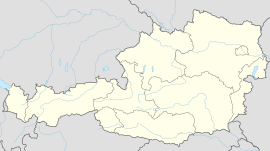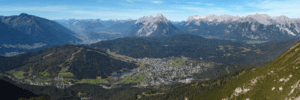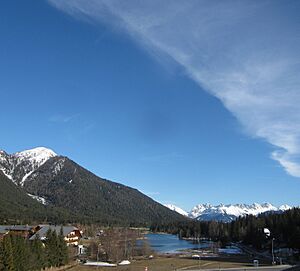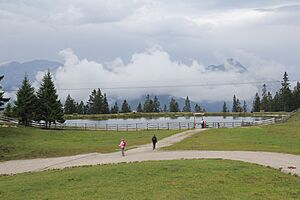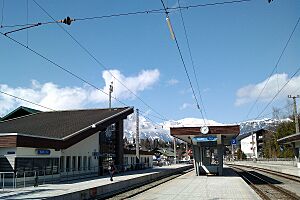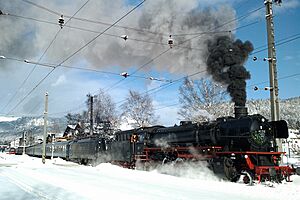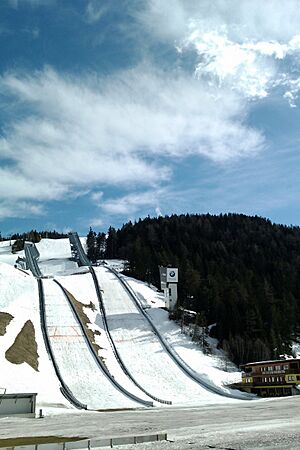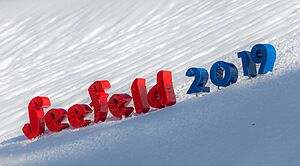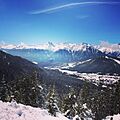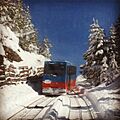Seefeld in Tirol facts for kids
Quick facts for kids
Seefeld in Tirol
|
||
|---|---|---|
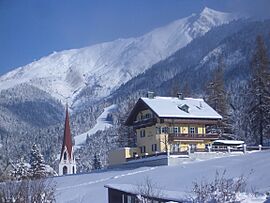
Seefeld in Tirol by wintertime
|
||
|
||
| Country | Austria | |
| State | Tyrol | |
| District | Innsbruck Land | |
| Area | ||
| • Total | 17.38 km2 (6.71 sq mi) | |
| Elevation | 1,180 m (3,870 ft) | |
| Time zone | UTC+1 (CET) | |
| • Summer (DST) | UTC+2 (CEST) | |
| Postal code |
6100
|
|
| Area code | 05212 | |
| Vehicle registration | IL | |
| Website | www.seefeld.eu | |
Seefeld in Tirol is an old farming village in Austria. It is now a very popular place for tourists. Seefeld is located in the Tyrol region. About 3,312 people lived there in 2013.
The village is about 17 kilometers (11 miles) northwest of Innsbruck. It sits on a high flat area called a plateau. This plateau is between the Wetterstein mountains and the Karwendel mountains. Seefeld is on an old road that was important for trade in the Middle Ages.
Seefeld was first mentioned in the year 1022. Since the 1300s, it has been a pilgrimage site. This means many people visited it for religious reasons. It was also a trading stop between Augsburg and Venice. People also started getting Tyrolean shale oil from the area in the 1300s.
Even before 1900, Seefeld was a popular holiday spot. Since the 1930s, it has been a famous place for winter sports. It is now one of the most popular tourist resorts in Austria. Seefeld has hosted parts of the Winter Olympics several times. It is also the home of Anton Seelos, who invented the "parallel turn" in skiing.
More than a million people stay overnight in Seefeld each year. It is a top place for skiing in winter. In summer, it is great for walking holidays.
Contents
Geography of Seefeld
Nearby Towns
Seefeld shares borders with several other communities. To the northwest is Leutasch. To the northeast is Scharnitz. The eastern border is with Zirl. To the south is Reith. To the west is Telfs.
The Land Around Seefeld
The village is on the Seefeld Plateau. This plateau faces south. It is north of the Inn River. The plateau is a flat area where water flows either to the Inn or the Isar rivers. Other villages like Leutasch and Scharnitz are also on this plateau.
The Wetterstein mountains are to the west. The Karwendel mountains are to the east. The land drops steeply down to the Inn valley in the south. To the north, a high valley leads to Scharnitz and the border with Germany.
Seefeld has two main mountain areas for walking or skiing. One is the Gschwandtkopf hill (1,495 meters high). The other is called Rosshütte. It is named after a big mountain restaurant. These mountains stand tall over the Seefeld Plateau. They include the Seefelder Joch, Seefelder Spitze (2,215 meters), Härmelekopf (2,224 meters), and Reither Spitze (2,374 meters).
Other important places include the Seekirchl. This is a small church with a round, onion-shaped dome. The Pfarrhügel is a small, pretty hill in the town center. There is also a popular swimming lake called the Wildsee.
Lakes and Streams
Water from the Haglbach stream flows into the Wildsee. The Wildsee is a lake that gave Seefeld its name. The Seebach stream flows out of the Wildsee. It runs north through Seefeld. It joins with the Raabach stream.
The Raabach stream starts in the southeast. It used to form a small lake. This lake gave the Seekirchl church its name. Near the Seebach, there is a special spring. It contains a small amount of radon. This spring was used for health until 1984.
The Klammbach stream starts near the Wildmoosalm. It flows northwest of the village. It joins the Seebach to form the Drahnbach. This stream flows towards Scharnitz. It then empties into the Isar River.
There is a reservoir called the Kaltwassersee near the Rosshütte. It holds a lot of water. This water is used to make snow for skiing.
Climate
Seefeld has a varied climate. Summers are generally mild. Winters are cold with lots of snow. The area gets a good amount of rain throughout the year. Snowfall is common from late autumn to spring.
Population
| Historical population | ||
|---|---|---|
| Year | Pop. | ±% |
| 1869 | 439 | — |
| 1880 | 448 | +2.1% |
| 1890 | 431 | −3.8% |
| 1900 | 420 | −2.6% |
| 1910 | 468 | +11.4% |
| 1923 | 619 | +32.3% |
| 1934 | 986 | +59.3% |
| 1939 | 1,130 | +14.6% |
| 1951 | 1,790 | +58.4% |
| 1961 | 1,801 | +0.6% |
| 1971 | 2,303 | +27.9% |
| 1981 | 2,476 | +7.5% |
| 1991 | 2,751 | +11.1% |
| 2001 | 3,098 | +12.6% |
| 2011 | 3,161 | +2.0% |
The number of people living in Seefeld has grown over time. In 1869, there were 439 people. By 2011, the population had grown to 3,161. This shows how the village has become more popular.
Culture and Sights
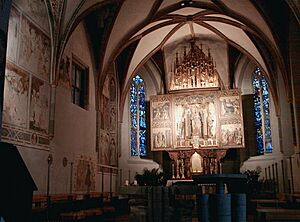
- Parish and Pilgrimage Church of St. Oswald: This is an important church in Seefeld. Many people visit it.
- Former Augustine Monastery: This old monastery is now a five-star hotel. It was built in 1516 by Maximilian I.
- Pfarrhof: This building is located above and south of the church.
- Lake Church of the Holy Cross (Seekirchl): This small church is a symbol of Seefeld. It was built between 1629 and 1666. It has beautiful paintings by Josef Anton Puellacher.
- Seefeld's Woodland Cemetery: This cemetery is on the eastern edge of the village. It has a chapel and a monument.
- Hermitage and Old Ruined Castle of Schlossberg: These old ruins are north of the village.
- Milestone: This stone marker was likely made by the Romans. A cross was carved into it later.
Getting Around Seefeld
Train Services
Seefeld is on the Karwendel Railway line. This line connects to Munich and Innsbruck. Seefeld station is the highest Intercity-Express (ICE) train stop in Europe. This means it's easy to reach Seefeld by train.
Bus Services
Several bus routes serve Seefeld. These buses connect the village to nearby towns. There is also a long-distance bus that stops at the Rosshütte.
| Bus number | Name | Route |
|---|---|---|
| 4184 | regiobus Tirol | Seefeld/Tirol - Leutasch - Oberleutasch - Buchen |
| 4186 | regiobus Tirol | Seefeld/Tirol – Gießenbach – Scharnitz – Mittenwald – Leutasch – Seefeld/Tirol – Reith – Leithen |
| 8354 | regiobus Tirol | Seefeld/Tirol - Mösern - Telfs |
| 040 | Flixbus | Innsbruck - Seefeld(Rosshütte) - Garmisch-Parten. - Munich Central Bus Station (Hackerbrücke) - Munich Airport |
Road Travel
The main road to the German border is the Bundesstraße 177. It is part of the European route E 533. This road goes from Zirl to Scharnitz and Mittenwald. Another road connects Seefeld to Telfs.
Innsbruck Airport is about 20 kilometers (12 miles) from Seefeld. In winter, there are direct flights from many cities.
Communication and Internet
Seefeld has modern communication services. Cable TV was first tested here in 1975. Now, many homes have it. You can also get fast internet access. There is free WLAN (Wi-Fi) in many public areas. These include the pedestrian zone and the spa park.
Sports and Activities
Seefeld has many great sports facilities. It is known as a "Nordic Competence Centre." This means it's a top place for training national teams.
- Toni Seelos Olympic Ski Jumps: These ski jumps are in the Casino Arena.
- Biathlon Stand: This area has 30 places for shooting.
- Cross-Country Skiing Trails: There are 279 kilometers (173 miles) of trails. Some are for skating style, others for classic style.
- Roller Skiing Route: This paved route is 3.6 kilometers (2.2 miles) long. It's used for practicing skiing without snow.
- Ski Slopes: There are special courses for slalom and giant slalom on the Gschwandtkopf.
- Ski Areas: The main ski areas are Rosshütte, Gschwandtkopf, and Geigenbühel-/Birkenlifte.
- Ice Rinks: You can go ice skating or play Bavarian curling.
- Football Fields: There are two grass fields for playing football.
- WM Halle: This building has 8 indoor tennis courts. There are also 4 outdoor courts.
- Seefeld Tennis Club: This club has 6 clay tennis courts.
- Golf Courses: There are two golf courses. One is the Seefeld-Reith Golf Club (9 holes). The other is an 18-hole course in Wildmoos (Telfs).
- Running and Nordic Walking Routes: There are 266 kilometers (165 miles) of marked paths.
- Cycling and Mountain Bike Routes: You can find 570 kilometers (354 miles) of routes.
- Beach Volleyball Court: A place to play beach volleyball.
- Riding Halls: Two indoor riding areas with outdoor paddocks.
- Fitness Studio: A gym for working out.
Economy and Tourism
Seefeld is a very important place for cross-country skiing. It hosted the Nordic events for the 1964 Winter Olympics and 1976 Winter Olympics. It also hosted parts of the FIS Nordic World Ski Championships in 1933, 1985, and 2019. Some events of the 2012 Winter Youth Olympics were also held here.
The 1963 Biathlon World Championships also took place in Seefeld.
The alpine skiing area is small. It is good for beginners. There are two separate areas. You can get between them by a free ski bus or taxi. The area is great for walks, shops, and the Olympia swimming complex.
Seefeld is popular with walkers because it is on a plateau. There are many nice walks that don't involve climbing big mountains. But walks into the mountains are also beautiful. The Karwendel is a huge nature reserve. You can even do multi-day walks through the Karwendel.
Seefeld is part of a group called Best of the Alps. This group includes eleven other top tourist towns.
Famous People
- Anton Seelos (1911–2006) was an Austrian alpine skier. He was a world champion. In the 1930s, Seelos invented the "parallel turn" in skiing. The Toni-Seelos-Olympiaschanze ski jump in Seefeld is named after him.
- Regina Schöpf (1935–2008) was an Austrian alpine skier. She competed in the 1956 Winter Olympics. She was born in Seefeld.
Images for kids
See also
 In Spanish: Seefeld in Tirol para niños
In Spanish: Seefeld in Tirol para niños



